Wine Bottle Holder Dimensions 101: What Fits Your House?

So you’ve started curating your own wine collection and you’re looking for a wine bottle holder to keep it safe and sound. If you’ve done a little research, you probably know that a cooling wine bottle holder is the best storage solution for any contemporary home: it keeps wines at just the right temperature and protects them from sunlight. Wine spoils quite easily, and if you do something as simple as leaving it out on the kitchen counter on a hot day, you could ruin the flavor, aroma, and mouth-feel…FOREVER.
But that’s why you’re here. It’s easy to look at wine bottle holders online and ooh and ah at their cool blue interior lighting, but actually conceptualizing how big they are in real life can turn into a headache, fast. That’s a major problem with online shopping in general. This guide’s goal is to help you quickly get a grasp on wine bottle holder dimensions, so you can know what fits in your house. Then you can start oohing and aahing at the different lighting options available!
Wine Bottle Holder Types
First, let’s separate wine bottle holders into three different types:
►Countertop wine bottle holders — These are compact and lightweight enough to be set right on top of your
kitchen counter or other table space without a large footprint or cracking the surface.
►Freestanding
wine bottle holders — These are medium to large coolers that are too tall and heavy to be set on the
counter. They can be placed on any level ground surface.
►Undercounter wine bottle holders — These
are designed to be installed in existing cabinetry, such as in a space where you previously had a trash
compactor.
There’s definitely overlap between these categories. For example, a countertop wine bottle holder is technically freestanding. And many undercounter units can also be used in freestanding applications. But to make things easy, you should think in the above terms when you’re looking at wine bottle holder dimensions for your house.
Countertop Wine Bottle Holder Dimensions
We appreciate how much thought you put into the multitude of speckles visible in your kitchen countertop and the soft shade of rose quartz you selected. So we know you want a small wine cooler that doesn’t look like a hulking beast crouching next to the fruit bowl. And even more important than aesthetic appeal, putting a too-big cooler on the counter is dangerous — it can topple over and cause a vintage disaster in the kitchen.
Countertop wine holders are compact. Typical dimensions are in the range of 14.00″L x 19.50″W x 19.00″H or 3.6 cubic feet total. Anything around these numbers or lower will be small enough to fit right in between the knife set and the paper towel holder. Counter units are usually more square or horizontally rectangular (like a toaster) than freestanding units. That’s because as the appliance gets taller, it gets more and more top-heavy and unsafe to set freely on an elevated surface.
The above dimensions translate into a cooler that can fit 12 bottles, with counter wine coolers maxing out at a 16 wine bottle capacity. In terms of heaviness, most weigh in at under 30 pounds. For example, the Magic Chef 12-Bottle Countertop Wine Cooler MCWC12B weighs 26.4 pounds, the Wine Enthusiast Silent 8 Bottle Countertop Wine Refrigerator weighs 29.6 pounds, th e Kalamera 12 Bottle Counter Top Stainless Steel Wine Cooler KR-12ASS weighs 26.5 pounds, and the NewAir AW-121E 12 Bottle Countertop Thermoelectric Wine Cooler weighs 26 pounds.
Remember that this weight is for the wine holder when it’s not actually holding any bottles. Though heaviness varies between wine bottles, let’s say that on average, a 750 mL one with everything included is about 2.85 pounds. A fully-loaded 12 bottle wine cooler that originally weighed 26 pounds would then weigh about 60 pounds total. Most counters should be able to hold this weight, but if you’re using the cooler on a desk, table, etc. confirm the weight capacity before you stick the appliance on top.

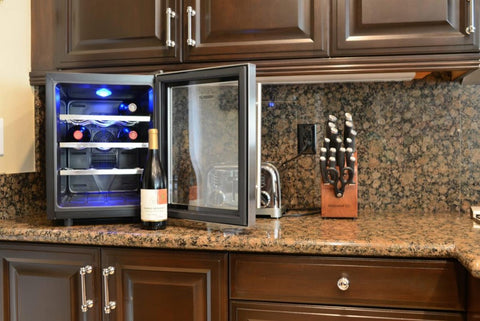
In terms of installation with these wine bottle holder dimensions, all you need is an electrical outlet. Most kitchen counters have plug access right in the back wall, so just position the cooler where it can easily reach this and then secure any extraneous cord length. Wine coolers come with “feet” for stability and to prevent the unit’s bottom from scratching surfaces, so make sure these are placed on a level surface. Also, keep the cooler out of direct sunlight and away from hot objects. And most importantly, there needs to be a 5″ clearance between the back of the unit and any adjacent walls.
What this means is that you should pull out your tape measure now (if you haven’t already done so), look for three possible non-sunny, flat surfaces in your house where you want to display some select bottles from your wine collection, and start measuring according to the above wine bottle holder dimensions plus the clearance space. Once you find a few options that catch your eye, start narrowing it down according to brand, cost, etc.
Freestanding Wine Bottle Holder Dimensions
As we mentioned before, countertop wine bottle holders are essentially freestanding coolers that are sized to fit on top of stuff. You can set a countertop wine cooler on the floor, but it would look kind of sad and small, and you’d have to bend into uncomfortable positions to access your wine.
In contrast, freestanding wine coolers are taller, heavier, and designed to be placed on the ground. These start in the 18 bottle capacity range and go right on up to more than 150 bottles, with a few units out there hitting the 200+ mark. The dimensions vary drastically, simply because the capacities vary so drastically as well. However, here’s a handy chart with example dimensions for different capacity wine bottle coolers:

| New Column | New Column | New Column | New Column |
|
Wine Bottle Capacity
|
Total Volume (Cubic Feet)
|
Dimensions (Inches)
|
Weight (Pounds)
|
|
18
|
4.04
|
14.00 L x 19.38 W x 25.75 H
|
34
|
|
28
|
6.4
|
20.88 L x 18.13 W x 29.25 H
|
50
|
|
46
|
9.8
|
23.50 L x 22.40 W x 32.20 H
|
104
|
|
116
|
20.4
|
23.50 L x 26.80 W x 56.00 H
|
183
|
|
160
|
25.5
|
23.50 L x 26.80 W x 70.00 H
|
222
|
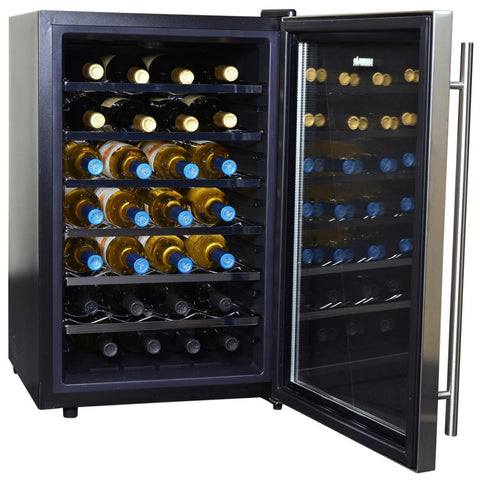
These dimensions often overlap with built-in wine coolers, but in that scenario, you’ll need to also take into account your cabinetry (more on that farther down). For now, it’s just important to keep these in mind as base starting points, because now is the time to pull out your measuring tape again and walk around your house.
You can put a freestanding wine cooler wherever you want, other than counters or desktops. They quite literally stand freely on the floor. Let’s take the NewAir AW-281E 28 Bottle Thermoelectric Wine Cooler for example. Like the countertop models, you just have to plug this in for it to start cooling (it also needs a 5″ gap between the rear and any nearby walls). The sunlight and hot object prohibitions apply here as well, so setting it next to your floor heater would be inadvisable, to say the least.
At about 2.5′ tall, the AW-281E could fit beside a recliner in the media room, beside the counter in the kitchen, behind your dry or wet bar, in a corner in the dining room, in the den or converted basement area, or anywhere you have floor space to set the appliance. The only other stipulation you’ll need to keep in mind in terms of freestanding wine bottle holder dimensions is the door.
After all, to access your wine and to pull out the removable racks, you have to be able to open the door. This isn’t as much of a problem with countertop wine coolers, since most counters aren’t home to big, bulky appliances or walls that could get in the way. But for floor wine bottle holders, you may run into some issues with nearby furniture.
The wine cooler door must open to at least a 90º angle; that is, perpendicular on the hinge to its starting closed position. So let’s do the math. The door will be essentially as wide as the cooler itself, e.g. about 18″ for the AW-281E. This means that when the door is fully opened on the wine fridge in this example, the total space lengthwise that you’ll need will be 18″ (open door length) + 18″ (wine cooler cabinet length minus the door thickness) + 5″ gap in the back = 41″ from front to back. These specific measurements vary per wine cooler, but you can do the rough calculations beforehand to see if you have room.
Undercounter Wine Bottle Holder Dimensions
Being able to fully open the door is especially important when it comes to wine coolers that can be installed within the cabinetry. In this case, not only do you have to worry about the front opening path, you have to consider clearance on the backside of the hinges. That’s why you’ll see a lot of built-in wine coolers with completely reversible doors, such as the NewAir AWR-520SB 52 Bottle Wine Cooler. What this means is that while the door hinge is on the left side by default, you can reverse the swing so that it opens from the right in case there’s an obstacle. If your cooler does not have a reversible door, it can’t be installed flush with cabinets — have it extend 2″.
Undercounter or built-in wine bottle holders have similar dimensions and weights to freestanding units, and many freestanding units also have the option to be installed. The determining factor is where the vent is on the cooler: if it’s in the back, you can’t enclose the cooler in a tight space. If it’s in the front, you’re good to go on the installation since the warm air has an escape route.
Suitable built-in wine bottle holder dimensions are restricted to what you have available in your house. By far the most popular installation location is in the kitchen cabinetry, but some daring souls like to expand into their living room wall units and the like. And while you can renovate the cabinetry to fit the cooler, it’s much easier if you already have a space to fill. For example, if you recently removed your trash compactor, then you could look for a wine cooler cabinet the size of a trash compactor so that it can fit right into that space.
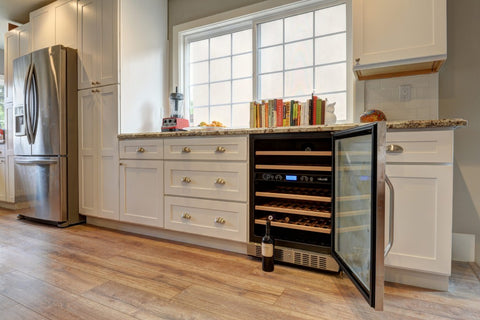
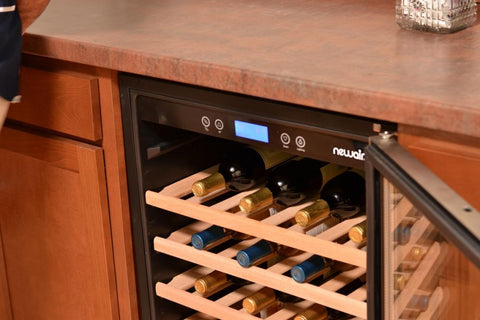
This means you need to whip out that measuring tape again and get the depth (length), width, and height of the hole. You also need to make sure you have access to an electrical source within this space, since the cooler needs to be plugged in to work. You should add an extra few inches to your depth measurement to ensure that the cord has room to breathe in the back. The included feet on wine bottle holders are generally adjustable, which also gives you some wiggle room in terms of height requirements.
As with anything, it’s always better if the space is slightly too big for the wine cooler rather than too small. Some models come with mounting hardware, which is screwed through the top of the cooler into the “roof” of the cabinetry. And if your wine bottle holder doesn’t end up sitting flush with the edges, don’t worry: you can simply apply some filler strips around the edges to make it look aesthetically perfect.
Also note that some built-in wine coolers cannot technically be installed “undercounter.” If you tried that with the 70″ tall NewAir AWR-1600DB for example, you’d end up with a broken kitchen and probably a broken back too. Instead, these big wine bottle holders can only be installed under upper wall cabinets, and in fridge nooks.
Hopefully this guide has helped build a picture of the actual dimensions of coolers. If you need further information on sizing your wine bottle holder, the NewAir appliance experts can help you down to the millimeter. Just let us know your question in the form below.


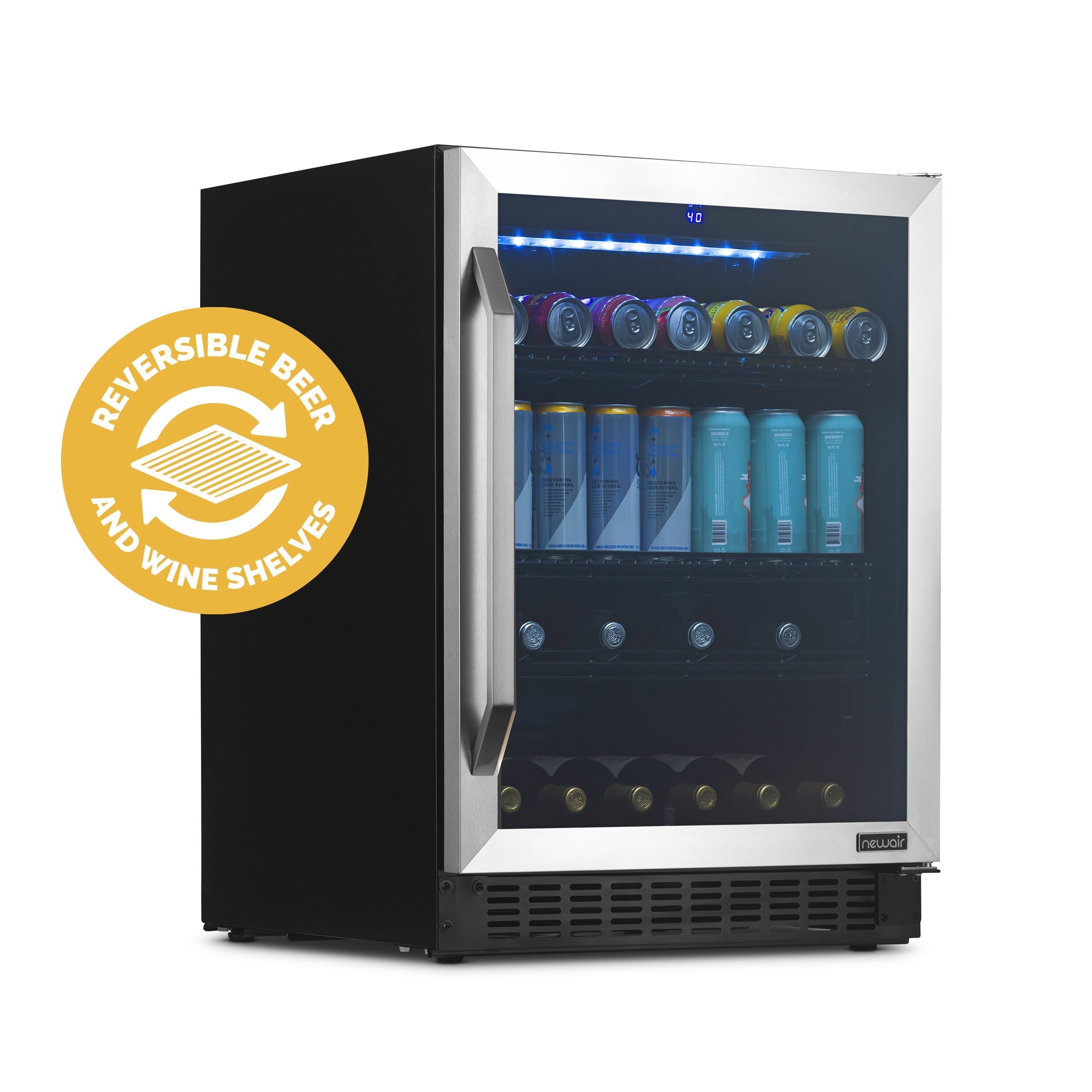
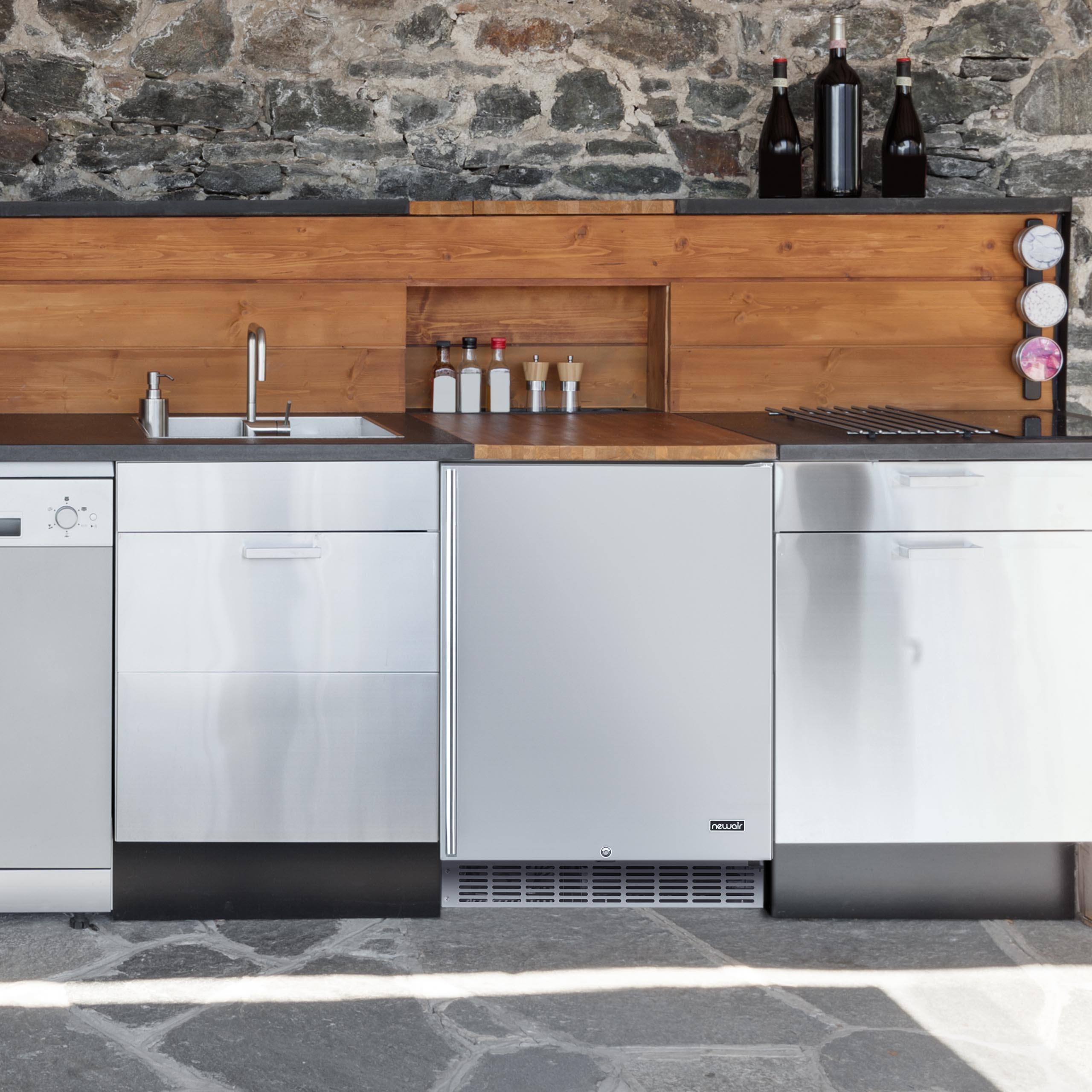
0 comments